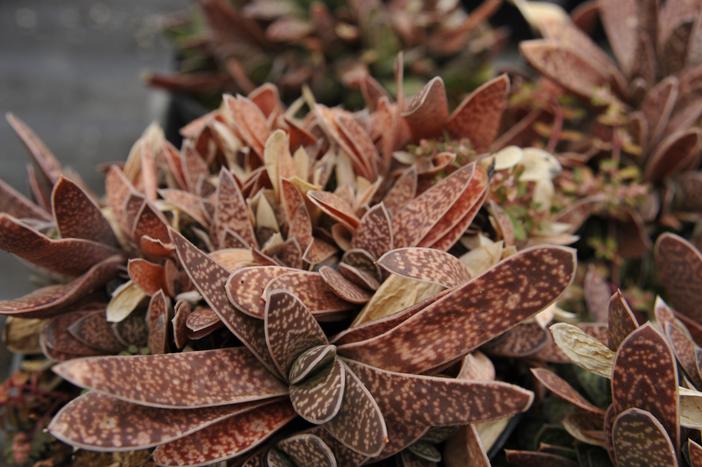Lawyer’s Tongue
(Gasteria obliqua)
Lawyer’s Tongue (Gasteria obliqua)
/
/

Megan Hansen
CC BY-SA 2.0
Image By:
Megan Hansen
Recorded By:
Copyright:
CC BY-SA 2.0
Copyright Notice:
Photo by: Megan Hansen | License Type: CC BY-SA 2.0 | License URL: https://creativecommons.org/licenses/by-sa/2.0 | Uploader: Uleli | Publisher: Wikipedia Commons












Estimated Native Range
Summary
Gasteria obliqua, commonly known as Lawyer’s Tongue, is a perennial succulent plant native to the arid, rocky slopes and outcrops in the Cape Regions of South Africa. It typically forms dense clusters with proliferous stems and shiny, mottled leaves that are arranged in a rosette pattern. The leaves are thick and fleshy, adapted to store water, and feature a distinctive oblique shape. Lawyer’s Tongue blooms in the late spring to summer, producing tubular pink to orange flowers on a spike that can reach up to 12 inches in height. The flowers are somewhat showy and attract pollinators such as bees and birds.
Gasteria obliqua is valued for its ornamental foliage and low maintenance requirements, making it a popular choice for rock gardens, container plantings, and as a houseplant. It is particularly noted for its ability to thrive in low light conditions, which is uncommon for many succulents. This species prefers well-drained soil and requires minimal watering, especially in the winter, to avoid root rot. During the summer, it benefits from more frequent watering but should still be allowed to dry out between waterings. In temperate regions, it requires protection from frost and is best grown indoors or in a greenhouse. The variety G. bicolor var. lilliputana, a dwarf form, has received the Royal Horticultural Society’s Award of Garden Merit for its particularly attractive appearance and ease of cultivation.CC BY-SA 4.0
Gasteria obliqua is valued for its ornamental foliage and low maintenance requirements, making it a popular choice for rock gardens, container plantings, and as a houseplant. It is particularly noted for its ability to thrive in low light conditions, which is uncommon for many succulents. This species prefers well-drained soil and requires minimal watering, especially in the winter, to avoid root rot. During the summer, it benefits from more frequent watering but should still be allowed to dry out between waterings. In temperate regions, it requires protection from frost and is best grown indoors or in a greenhouse. The variety G. bicolor var. lilliputana, a dwarf form, has received the Royal Horticultural Society’s Award of Garden Merit for its particularly attractive appearance and ease of cultivation.CC BY-SA 4.0
Plant Description
- Plant Type: Succulent
- Height: 0.5-1 feet
- Width: 1-2 feet
- Growth Rate: Slow
- Flower Color: N/A
- Flowering Season: Spring
- Leaf Retention: Evergreen
Growth Requirements
- Sun: Part Shade, Full Shade
- Water: Low
- Drainage: Medium, Fast
Common Uses
Drought Tolerant, Low Maintenance, Potted Plant, Rock Garden
Natural Habitat
native to the arid, rocky slopes and outcrops in the Cape Regions of South Africa
Other Names
Common Names: Cow Tongue, Ox Tongue
Scientific Names: , Gasteria obliqua, Aloe bicolor, Aloe boureana, Aloe bowieana, Aloe dictyodes, Aloe formosa, Aloe guttata, Aloe lingua, Aloe lingua
GBIF Accepted Name: